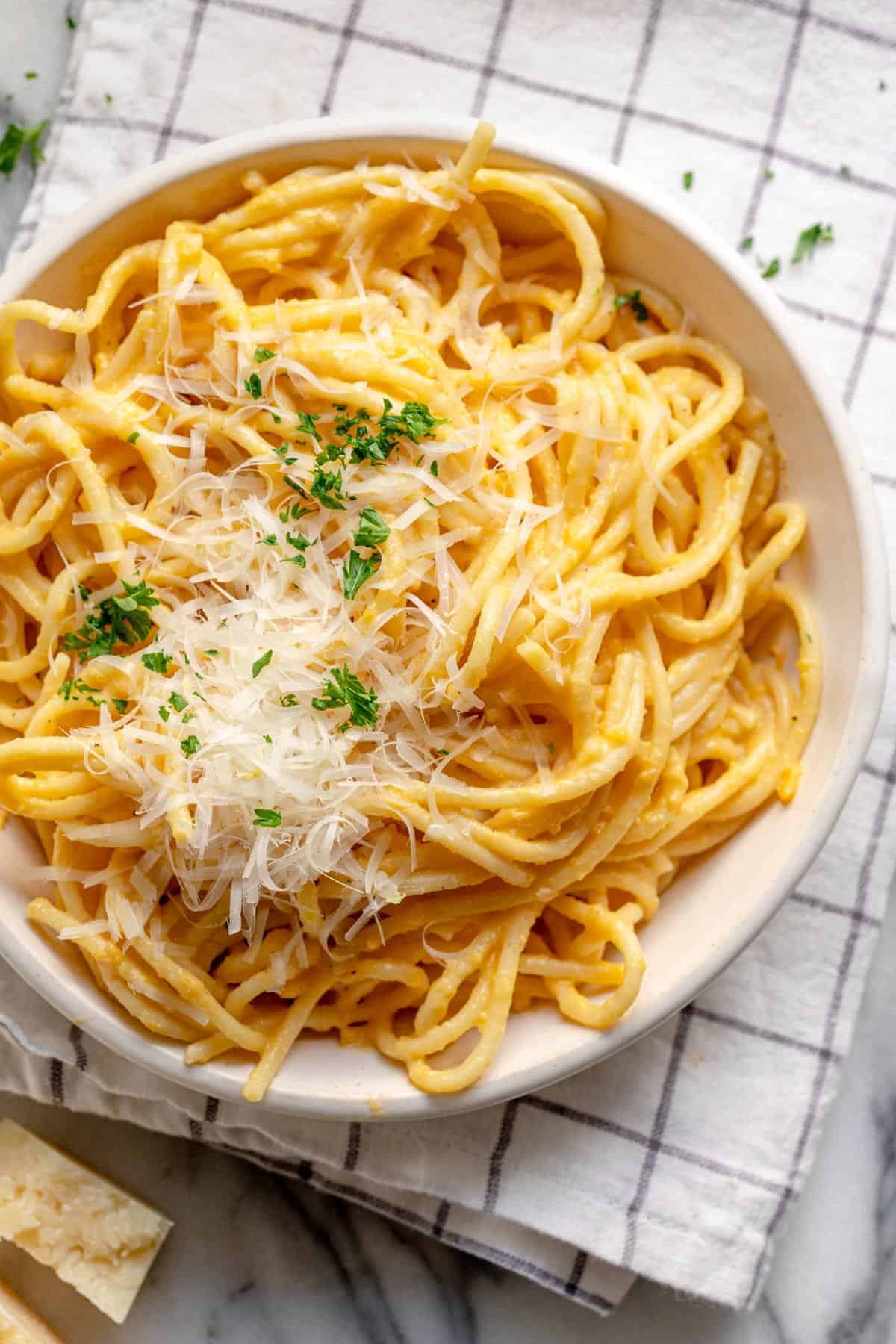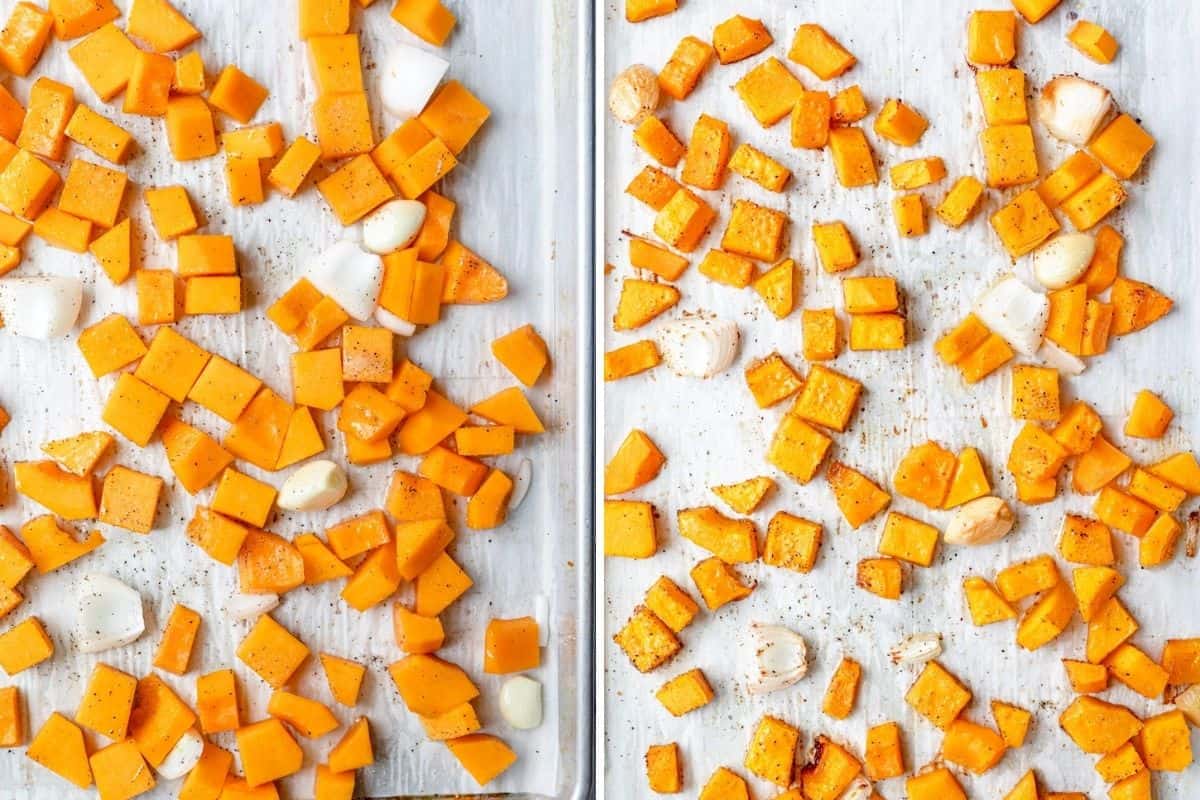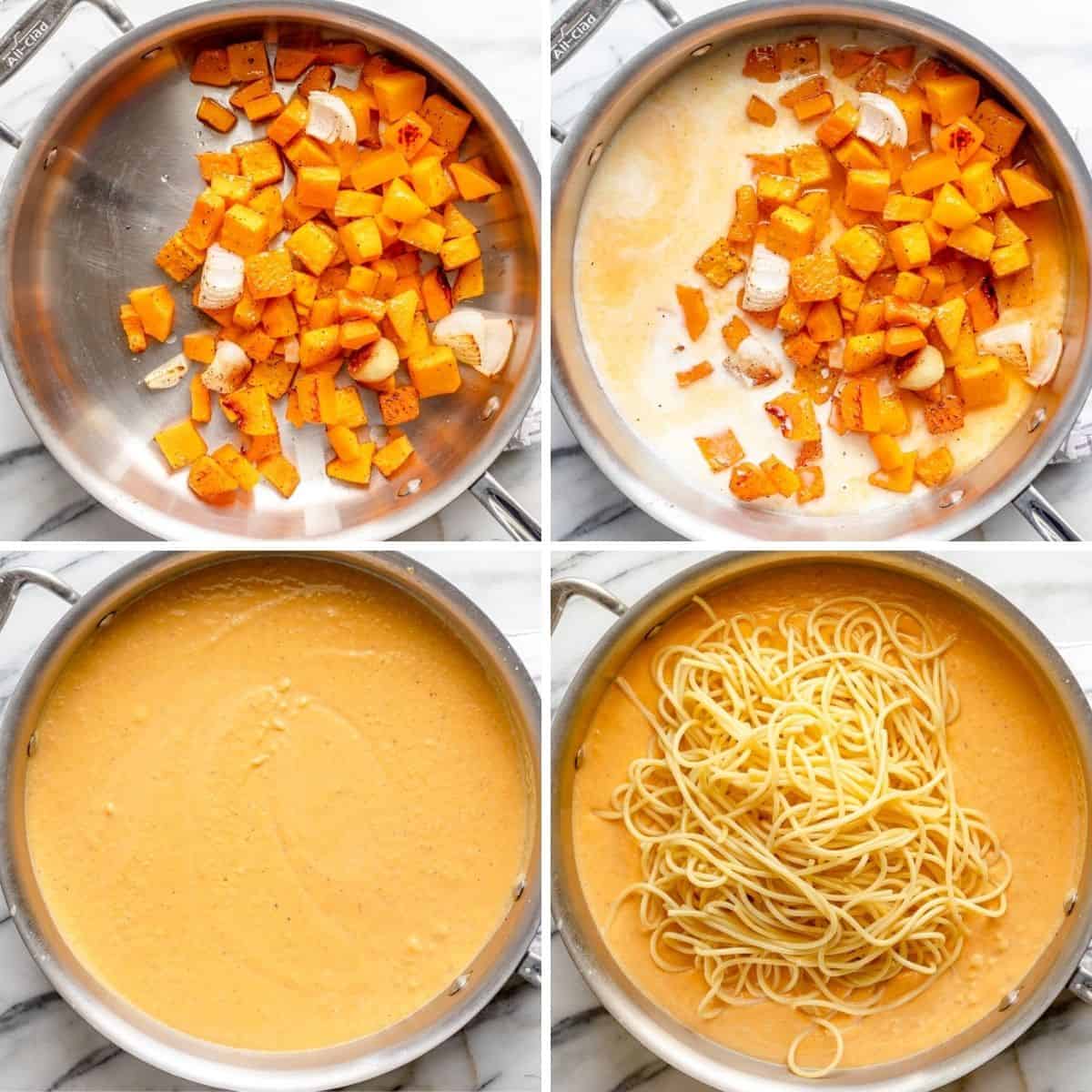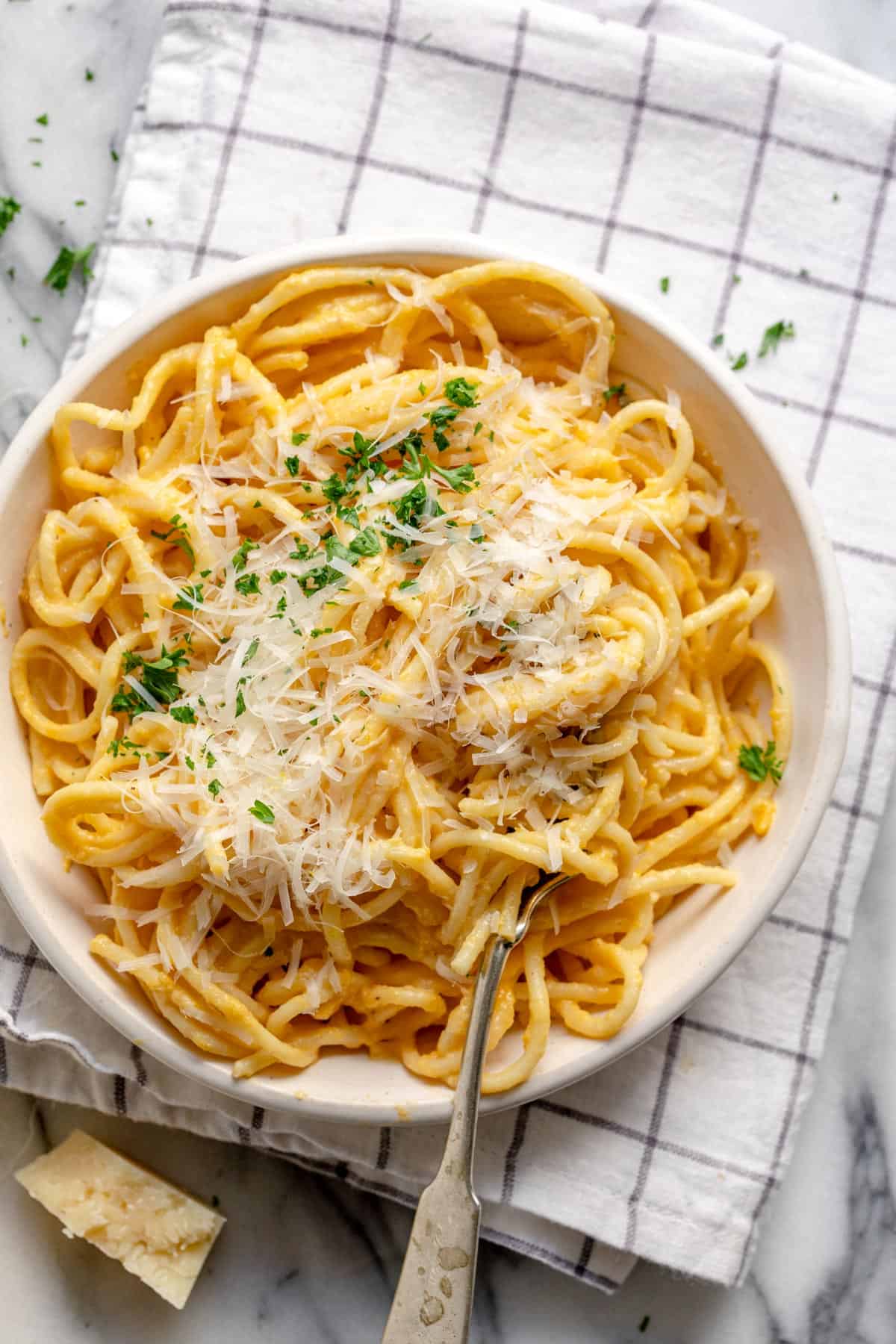Creamy Butternut Squash Pasta
Updated Nov 04, 2023
Effortless to make, this creamy butternut squash pasta is made with roasted butternut squash and a few simple ingredients for a delicious easy family meal.
This post may contain affiliate links. Please read our disclosure policy.
This delicious creamy and cheesy butternut squash pasta is a great meat-free family weeknight meal. If you’re like me and can’t help but add butternut squash to almost everything once fall rolls around, you have to try this butternut squash pasta sauce. Instead of relying on heavy cream, I’m using roasted butternut squash, garlic, and onion to whip up a sauce that’s creamy without feeling heavy. I simply roast the veggies on the same baking sheet, blend them with a splash of milk and vegetable broth, and pour everything on top of some al dente pasta. So easy and so good.

When it comes to comfort food with a touch of elegance, nothing hits the mark quite like butternut squash pasta. This recipe transforms humble ingredients like butternut squash and onions into a velvety, luxurious sauce that perfectly clings to spaghetti. When I first made this, my kids were skeptical. But once they tasted it, guess what? Big win! It somewhat reminded them of my Butternut Squash Mac and Cheese recipe – which they also love. Of course, this one doesn’t include any cheese besides some grated parmesan, but due to the creaminess of the sauce, you can’t even tell!
Jump to Section
- Recipe At a Glance
- Ingredients to make butternut squash pasta
- How to make butternut squash pasta
- Tips for making the best creamy butternut squash pasta
- Popular substitutions & additions
- How to store & reheat butternut squash pasta
- Frequently asked questions
- What to serve with your pasta when serving as the main dish
- What to serve with butternut squash pasta when using it as a side
- More pasta recipes:
- Creamy Butternut Squash Pasta Recipe
Recipe At a Glance
Cuisine Inspiration: American, Italian
Primary Cooking Methods: Roasting, Stovetop
Dietary Info: Vegetarian
Key Flavor: Savory, Earthy
Skill Level: Easy
Summary
- Quick Prep: This pasta is ready in under 40 minutes, from start to finish.
- Hidden Veggies: The sauce packs in nutritious butternut squash and other vegetables, cleverly disguised. Perfect for picky eaters.
- Meal Prep Friendly: The sauce can be made in advance and stored, making it perfect for those nights when you just want to pull something out of the freezer and eat.
- Easy Steps: With straightforward steps like roast, blend, and combine, even amateur cooks can master this easy butternut squash pasta in no time.
Ingredients to make butternut squash pasta
- Butternut Squash: Make sure it’s peeled and cubed. You could also use frozen pre-cubed squash if you’re short on time.
- Onion & Garlic: These add a deep flavor when roasted. Yellow or white onions work best, but if you don’t like the flavor of onions, shallots can be a milder choice.
- Olive Oil: For roasting. You can substitute with avocado oil or another cooking oil you prefer.
- Salt & Black Pepper: Essential seasonings. Adjust according to your taste.
- Vegetable Broth: It adds flavor and helps in thinning out the sauce.
- Milk: This makes the sauce creamy. You can go with almond, oat, or soy milk if you’re looking for a dairy-free option.
- Spaghetti: Any pasta can work, but spaghetti really soaks up that sauce well. However, you can use your fave pasta type – penne, fettuccine, or even zoodles for a low-carb substitute.
- Parmesan Cheese: For serving. Adds a salty, cheesy kick to the finished creamy butternut squash pasta.
- Parsley: Freshly chopped for garnish. You could also use basil or even chives.
How to make butternut squash pasta
- Place the butternut squash, onions, and garlic on a baking sheet, drizzle with olive oil, and season.
- Roast until golden brown and starting to caramelize.

- Transfer the roasted squash to a pan.
- Add the vegetable broth, milk and reserved pasta water.
- Blend until smooth.
- Add in the cooked pasta.

- Toss the pasta with the sauce and serve with grated parmesan and chopped parsley.

Tips for making the best creamy butternut squash pasta
- Learn how to cut up butternut squash the best way into cubes. I created a tutorial for cutting up the squash to help break it down.
- Save on dishes by boiling butternut squash in a large pot instead of roasting it. Here’s a quick guide on cooking butternut squash with different methods. You can boil it with the garlic and onions and then blend it right in the pot and add the pasta on top. I prefer the taste of it roasted though.
- Roast the butternut squash as a whole sliced in half. This saves on time from peeling the skin and cutting into cubes. However roasting smaller pieces enhances the caramelization process and improves the flavor overall.
- Don’t toss the pasta water! Some of the cooking water for the pasta is stirred into the sauce. This helps to add flavor, and the starch in it helps to thicken the sauce and help it stick to the pasta. If you use tap water in its place, the sauce will be runnier.
- Cook the pasta in salted water. This helps to add flavor to the dish right from the beginning. Be sure to get all of my best tips for perfectly cooked pasta every single time!
Popular substitutions & additions
- Add protein. Although I like to keep this recipe meat-free, you can add some chicken or air fryer tofu cubes to the sauce before serving for a heartier and protein-rich meal.
- Swap regular pasta with whole grain. If you want an even more healthy butternut squash pasta, use quinoa spaghetti or brown rice noodles. They’re packed with nutrients and offer a different texture.
- Mix in some cheese. Besides parmesan, you can mix in some creamy ricotta into the sauce for added richness.
- Add different spices. A dash of nutmeg or a sprinkle of chili flakes pair beautifully with the savory and slight sweetness of the squash. If you’re worried about them overpowering the flavors of the sauce, don’t be – those spices just add a hint of warmth and heat.
How to store & reheat butternut squash pasta
If you want to make this recipe for meal prep, you can make the sauce up to 3 days in advance and store it in the fridge. When ready to use, reheat on a skillet adding more milk or pasta water as needed. Then toss in the cooked pasta.
Once you mix the sauce with the pasta, you can store any leftovers in an airtight container inside the fridge. To reheat them, simply pop them into the microwave in a microwave-safe dish for a few minutes and give them a good stir every 30 seconds to ensure even heating.
How long will this butternut squash pasta last in the fridge?
This creamy pasta will stay good in the fridge for up to 4 days. Any longer, and you might not get that fresh taste or the best texture from the pasta and sauce.
Can I freeze butternut squash pasta sauce?
Yes, you can also freeze the sauce for up to 3 months if you decide to only use half of it. Just allow it to cool completely, then transfer to a freezer-safe container, making sure to leave room for expansion. I would not recommend freezing the pasta with the sauce, though.
Frequently asked questions
Once the pasta is mixed with the sauce, it’s best to serve the dish straight away, but you can get ahead with this dish.
You can roast the butternut squash 2 to 3 days ahead of time and keep it covered in the fridge. You can also make the sauce a couple of days ahead of time, then just heat it through before adding the cooked pasta.
If you do have leftovers, they will keep for up to 3 to 4 days in the fridge and can be reheated gently on the stovetop. You may want to add a little water when you reheat to loosen the sauce back up.
This butternut squash pasta is vegetarian, and you can easily make it vegan. Use a plant based milk instead of dairy, unsweetened almond, oat or soy would work well, and simply skip the cheese when you serve it.
I like to make this with a long pasta like spaghetti or linguini and the butternut squash sauce will cling to it. This, of course will work well with whatever pasta you have to hand, and simply use your favorite gluten-free pasta if you have an intolerance.
If your sauce is on the runny side, an easy way to thicken it is to simmer the sauce on the stove for a bit longer, allowing it to reduce. Alternatively, you can add a slurry: mix a tablespoon of cornstarch with a couple of tablespoons of cold water, then stir it into the sauce and cook for a couple of minutes until it thickens up.
What to serve with your pasta when serving as the main dish
What to serve with butternut squash pasta when using it as a side

This butternut squash pasta is such a great family meal that is effortless to make, and it’s so wonderfully creamy and comforting. It’s a great way of sneaking some veggies onto the plate without anyone knowing too!
More pasta recipes:
- Baked Pasta with Ground Turkey
- Baked Feta Pasta
- One Pan Pasta
- Lemon Ricotta Pasta
- Arrabiata Pasta with Shrimp
- Spaghetti Squash Lasagna
- Pan Seared Scallops with Pasta
If you’ve tried this healthy-ish feel good Creamy Butternut Squash Pasta recipe or any other recipe on Feel Good Foodie, then don’t forget to rate the recipe and leave me a comment below! I would love to hear about your experience making it. And if you snapped some shots of it, share it with me on Instagram so I can repost on my stories!

Creamy Butternut Squash Pasta
Video
Ingredients
- 1 medium butternut squash peeled and cut into 2-inch cubes
- 1 small onion quartered
- 4 garlic cloves
- 2 tablespoons olive oil
- ½ teaspoon salt
- ½ teaspoon black pepper
- 1 ½ cup low sodium vegetable broth
- ½ cup milk
- 1 pound spaghetti
- Grated parmesan cheese for serving
- Chopped parsley for serving.
Instructions
- Preheat oven to 425°F. Line a large baking sheet with parchment. Place the butternut squash, onions and garlic on the baking sheet. Drizzle with olive oil and season with salt and pepper. Roast until squash is lightly caramelized and golden, about 30 minutes.
- While the butternut squash is roasting, cook the pasta in a pot of salted water according to package instructions until al dente. Drain, reserving ½ cup of the cooking liquid.
- Transfer the roasted butternut squash to large saucepan. Add the vegetable broth, milk and pasta water, and use an immersion blender to blend until smooth.
- Add the cooked pasta to the butternut squash sauce and toss to combine. Serve warm with grated parmesan cheese and chopped parsley, if desired.
Notes
- Instead of vegetable broth, you can use more milk or more pasta water or a combination of the two.
- Instead of milk, you can use heavy cream for a more creamy consistency, unsweetened almond milk for a plant-based version or more vegetable broth for
- Instead of spaghetti, you can use any pasta of choice.
Nutrition
Nutrition information provided is an estimate. It will vary based on cooking method and specific ingredients used.






Comments
Amazing kids friendly recipe on this blog!
Can I roast frozen squash in this recipe?
Thank you so much! Yes, you can.
Is this 606 calories PER SERVING?
Yes, that’s correct!
Sorry to say whatever I did turned out Terrible. Was more like a purée than a sauce and whatever you do, don’t use angel hair.
I’m sorry to hear that. The purée texture likely comes from butternut squash being the main ingredient. I find adding some of the cooking water from the pasta into the sauce, so the starch in it can help to thicken the sauce and help it stick to the pasta!